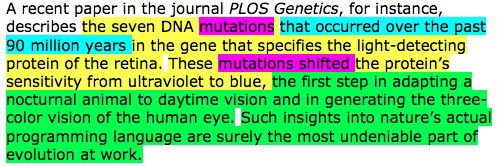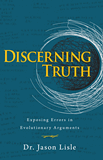
Pardon Me, Your Presuppositions Are Showing
News to Know
Abstract
News to Know covered many topics in 2014, but, really, there’s nothing new under the sun when it comes to countering evolutionist claims.
Every week News to Know features articles about science in the news. Our analyses help readers distinguish between fascinating scientific discoveries and unverifiable evolutionary assumptions, between discoveries that truly enhance our understanding of the world and worldview-based conclusions that perpetuate an imaginative view of the past.
We would like to wrap up 2014 with a practical lesson about how to distinguish observable science from evolutionary presumptions in the popular press. To that end, we’ll start by examining a paragraph from a recent item in the Wall Street Journal, Nicholas Wade’s book review of Bill Nye’s book Undeniable entitled “Bill Nye the Darwin Guy”:1
Mr. Nye writes briskly and accessibly. He favors short, sound-bitey sentences. He is good on the geological and fossil evidence for evolution, reflecting his background in the physical sciences, but devotes less attention to changes in DNA, which furnish the most direct evidence of evolution. A recent paper in the journal PLOS Genetics, for instance, describes the seven DNA mutations that occurred over the past 90 million years in the gene that specifies the light-detecting protein of the retina. These mutations shifted the protein’s sensitivity from ultraviolet to blue, the first step in adapting a nocturnal animal to daytime vision and in generating the three-color vision of the human eye. Such insights into nature’s actual programming language are surely the most undeniable part of evolution at work.1
Spotting Presuppositions
Whether in the popular or the peer-reviewed press, a discerning reader will be on the lookout for an author’s presuppositions. Science is not as purely objective as many would like to think. The scientific method enables us to repeatedly test observable hypotheses but can only give insight into the unobservable past in light of what we can know from reliable eyewitness accounts of the past. Each scientist has presuppositions about just what accounts of the now-unobservable untestable past he or she considers reliable.
Let’s take a look at Wade’s claims in the quoted paragraph. Wade announces his own belief that molecules evolved into man when he writes that DNA furnishes “the most direct evidence of evolution.” Does it? He adds, “Such insights into nature’s actual programming language are surely the most undeniable part of evolution at work.” Are they really? Not at all.
DNA furnishes direct evidence of how organisms encode heritable genetic information, not how the information came to exist in the first place. Neither is there a tag on the DNA announcing how long ago a genetic variation came to exist. Any such determination rests on both the knowledge and constancy of past mutation rates, actual knowledge of the origin of the gene, and some way to calibrate the “clock of life,” which is itself presupposition dependent. A bottle of wine is labeled with its vintage, but the information in DNA does not contain a label naming its age. Claims about when a particular trait or gene evolved are spun from the circular reasoning and unverifiable assumptions inherent in molecular clock dating. Suffice it here to say that molecular clock claims such as the “90 million years” Wade cites comes from a stack of unverifiable presumptions in which molecules-to-man evolution of complexity is simply assumed to have occurred and dates drawn from the equally unverifiable dates assigned to the fossil record are then used to calibrate how long it took.
Discover the Discovery
Next, in examining the scientific claims reported in the media, a discerning reader will look for the discovery. What did the scientists actually observe (if anything)? Some journalists and some scientists interviewed about their studies focus heavily on the perceived evolutionary significance of the work rather than on what they actually observed.
Some studies sadly contain no observations at all, only statistical analyses steeped in evolutionary paradigms that try to put the evolutionary tree of life in order or use it for some higher purpose; “Can Evolutionary Clues Cure Cancer?” recounted one of these. Researchers in that study claimed that oncologists should seek the cure for cancer in their “knowledge” of how life evolved. Others, like “Rodent-like Mammal Shakes the Evolutionary Tree,” describe a fossil and weave an evolutionary story around it. In this case, Wade mentions genuine scientific observations, but he entwines them with evolutionary presumptions, both his own and those of the scientists involved. Let’s look at that again:

Unlike my husband, I am not colorblind; therefore I typically color code key passages. Here, I have highlighted the observational science Wade describes in yellow, the portions that might involve evolutionary presumption in purple, the long-age evolutionary presumptions in blue, and the biological evolutionary presumptions in green. From this brief analysis, I see that a recent discovery identified seven sites on a gene encoding a visual pigment where such differences correlate with the wavelength the pigment detects. That is the discovery.
I have learned to be wary of calling the differences between various genes mutations. Sometimes the word is used correctly: to describe for instance the changes that occur within a specific kind of organism producing phenotypic variations. Sometimes, however, the word mutation is used on the presumption that all life evolved from a common ancestor and therefore all genetic differences are simply the result of mutations over time. (This assumption is unverifiable. It is in the province of our unobservable untestable origins. Furthermore, it is inconsistent with observable biology because organisms only reproduce and vary within their own kinds.) Thus the word mutation is a key word to watch for, as context will help determine whether it is weighted with evolutionary assumptions. When in doubt, you can safely substitute the word variations or differences until you gather more information. We can safely assume the writer here is referring to seven observable variations in a gene and the phenotypic functional differences associated with them.
In green I have noted biological evolutionary presumptions—the idea that nocturnal animals evolved to produce those with daytime vision and the idea that the three-color vision of the human eye had to evolve. Wade considers this “undeniable” evidence of molecules-to-man evolution.
Researching the Research
Identifying the genetic differences between organisms is observational science. Assuming that differences are the product of millions of years of evolving complexity is pure presumption. The discerning reader can see the difference.
A further look at material in the media, for me at least, usually involves a look at the peer-reviewed article at the root of a popular journalist’s report. Today some, though certainly not all, of these articles are freely available online, and most at least have an abstract posted for public viewing. The jargon inherent in any scholarly report can of course be daunting, but a look at the original source sometimes provides another angle on the claims in the media. At times (though not here) researchers report far more evolutionary claims in their interviews with reporters than in their peer-reviewed articles. In this case, a close look at “Epistatic Adaptive Evolution of Human Color Vision” in PLOS Genetics (18 December 2014) (accessible at www.plosgenetics.org) shows that the researchers compared the genes corresponding to a visual pigment in organisms ranging from fish to frogs, canaries to cows, mice to monkeys, and elephants to humans. They assumed that evolution occurred and then tried to guess the path it took.
Identifying the genetic differences between organisms is observational science. Assuming that differences are the product of millions of years of evolving complexity is pure presumption. Yet Nicholas Wade, the Wall Street Journal science writer, considers this DNA evidence the best thing going in support of biological evolution. The discerning reader can see the difference.
Common Designs or Common Ancestor?
Many readers will then wonder why so many organisms have a gene encoding varieties of this visual protein. From both biblical understanding and observable biology we know that living things only reproduce and vary within their created kinds. Yet we also know that God is the Common Designer of all. The light-sensitive molecule God placed in the visual systems of most animals and humans is called an opsin.
Opsin molecules are responsive to various wavelengths of light. Absorbing a photon of light triggers a change in their shape. The brain interprets this molecular shape-change as light or color. Minor structural differences in opsin molecules alter the optimal wavelength range of sensitivity. Different opsins optimize the vision of each created kind for its environment and needs. In the case of humans, our light-detecting retinal rods have an opsin pigment and our color-detecting retinal cones have three different opsins, each suited for a different wavelength.
Our Creator used similar anatomical designs in diverse organisms, so we see He used many of the same sorts of molecules—including proteins and the genes that code for them—in diverse creatures. Common designs—genetic or anatomical—are exactly what we would expect to see in a world created as God described in His Word. Learn more about the absurdity of the evolutionary claims about the human eye in Dr. Tommy Mitchell’s presentation, “Evolution: The Eyes Don’t Have It,” freely available on-line along with other presentations from our Design(er) Conference.
Dr. Tommy Mitchell elaborates on many problems with claims that human vision evolved and highlights the great Designer of our eyes in his online video “Evolution: The Eyes Don’t Have It.”
Cats, Caffeine, and Quadrupedal People

Image courtesy of Elizabeth Mitchell.
Let’s take a brief look at how these principles played out in some of our most popular News to Know reports over the past year. The same sort of genetic comparisons were used to expand our knowledge of cats and caffeine. “How Domestic Cats Differ from Wildcats and Other Carnivores” covered a recent comparison of the genes in wild and domestic cats to those of other mammals. This study correlated some of the traits characteristic of cats in general and domestic cats in particular to the genes that make them possible. It also correlated some cat/canine distinctions with feline/canine genetic differences. These are all examples of observational science.
The researchers then moved into discussions of how cats acquired some of their genetic distinctives through “enrichment.” Here they were presuming without proof or verifiable precedent that genes were added to an evolving genome inherited from a less-carnivorous non-cat ancestor. There is no evidence that this happened nor any known mechanism whereby it could. Thus, at this point the study had veered from solid observational science into evolutionary presumption.

Image by Josve05a, via Wikimedia Commons.
Similarly, in “Caffeine: Convergently Evolved or Creatively Provided” we saw how the genes that make the enzymes needed to produce caffeine are found in different places in the genomes of the major caffeine producers—coffee, tea, and cacao. This was an example of observable science. But because the genes to accomplish the same function are located in such different places in the genomes, the researchers presumed the genes for making caffeine had to evolve again and again. In fact, only evolutionary presupposition demands an evolutionary explanation for the presence of the caffeine genes in different places.
Biologists have discovered that many plants produce caffeine and those that do reap a variety of benefits, such as memory enhancement in their pollinators that return again and again for another boost. From a biblical point of view we can understand that caffeine is a molecule useful to many plants and that the common Designer of all would have supplied many sorts of plants with it, obviating the need for any evolutionary story to explain it. The biblical explanation cannot be proven by observational science either, but unlike evolutionary explanations it is consistent with both observable biology and the historical eyewitness account of the Creator God.

Image from BBC.
In “Quadrupedal People Do Not Walk Like Chimpanzees,” we saw how victims of Uner Tan syndrome have been viewed as evolutionary throwbacks because their mental deficiencies combined with their inability to walk upright on their two legs. This evolutionary presumption had led earlier investigators to misinterpret the quadrupedal gait of Uner Tan sufferers as ape-like. This evolution-driven label was perpetuated in a popular BBC production.
In a fine piece of observational science, anthropologist Liza Shapiro truly observed videos of Uner Tan victims walking and refuted the claim that they walk like apes. Of course a Bible-believing viewer of videos and articles about these people would not be fooled into thinking they were examples of “reverse evolution” in the first place. Now observable evidence has demonstrated that there was never anything ape-like in their walk. What a pity that funds were expended to score evolutionary points using these people rather than in finding ways to improve their lives.
Yardstick for Truth
As we read science news columns, it is important to remember that the yardstick by which truth is judged is the Word of God. The Bible is not a science textbook, nor is it a history textbook, but wherever it addresses matters of science and history, it is true and reliable. No good scientist—regardless of worldview—would claim to have all knowledge about anything, for science involves an ongoing process of discovery. But when drawing conclusions about the unobservable, untestable past, those that violate the truth of God’s Word are incorrect. Dr. David DeWitt explains how to apply this principle in “Does the Creation Model Make Predictions? Absolutely!”:
Importantly, while my faith in the biblical account of creation caused me to doubt the conclusions of the scientific study [which seemed to show that Neanderthals were genetically unrelated to humans], I was not content to leave it at that. As a scientist, I needed to have evidence that I could use to contradict the reported conclusive results. I could not just say, “Since the result doesn’t match the Bible, it is wrong.” No, as a scientist, I was compelled to find out why the conclusion was wrong based on scientific data within the framework of the Bible’s claims. Since I believed the Bible was true, it provided the motivation to pursue a study to show that Neanderthals really were descendants of Adam and Eve, even though this was counter to the secular scientific consensus at the time.2
Likewise, there will be times when a reader will see that a particular statement by a journalist or a scientist violates Scripture but not discern the correct explanation. Sometimes it is necessary to await more information. This is true for both scientists and the public. Again Dr. Dewitt explains the correct approach to the oh-so-impressive-sounding evolutionary claims we see almost daily in the press:
As Christians, we should have the courage and conviction to believe that what the Bible says about creation is true. Then, when we encounter evidence that at first appears to support evolution, we will not doubt the Scripture. Instead, we will press on to figure out the flaws in the evolutionary argument. There have been numerous times in my life when I have been confronted with evidence for evolution that seemed really compelling, but if I struggled with it and waited, eventually I (or someone else) found the flaw. This reinforces my faith in the God who made the universe.2
It is important to read the science news with discernment and to be prepared to have answers when others challenge us with unbiblical claims. And rather than leaping to unsubstantiated conclusions ourselves, sometimes we must be willing to search and even to wait for more information to have answers as complete as we would like. Yet we are on safe ground if we determine to stand firm on the Bible’s history, the Bible’s science, and above all the Bible’s truth about the need each person has for Jesus Christ to save him or her from sin. Let each of us take that truth into the new year, determined to be prepared with answers (1 Peter 3:15) for those who want to know why we would trust in the Creator God of the Bible and see a need to know His Son Jesus Christ as our Savior and Lord.
Further Reading
- What Is Science?
- Deceitful or Distinguishable Terms—Historical and Observational Science
- Jesus, Evangelical Scholars, and the Age of the Earth
- Review of the Lecture “Evolution & Creation: Conflicting or Compatible?”
- Can Bible-Based Predictions Lead to Scientific Discoveries?
For More Information: Get Answers
Remember, if you see a news story that might merit some attention, let us know about it! (Note: if the story originates from the Associated Press, FOX News, MSNBC, the New York Times, or another major national media outlet, we will most likely have already heard about it.) And thanks to all of our readers who have submitted great news tips to us. If you didn’t catch all the latest News to Know, why not take a look to see what you’ve missed?
(Please note that links will take you directly to the source. Answers in Genesis is not responsible for content on the websites to which we refer. For more information, please see our Privacy Policy.)
Footnotes
- Nicholas Wade, “Bill Nye the Darwin Guy,” Wall Street Journal, December 22, 2014, http://www.wsj.com/articles/book-review-undeniable-by-bill-nye-1419293145.
- Dewitt, D., “Does the Creation Model Make Predictions? Absolutely!,” Answers in Genesis, February 8, 2014, https://answersingenesis.org/creation-science/does-the-creation-model-make-predictions-absolutely/.
Recommended Resources

Answers in Genesis is an apologetics ministry, dedicated to helping Christians defend their faith and proclaim the good news of Jesus Christ.
- Customer Service 800.778.3390
- Available Monday–Friday | 9 AM–5 PM ET
- © 2025 Answers in Genesis




